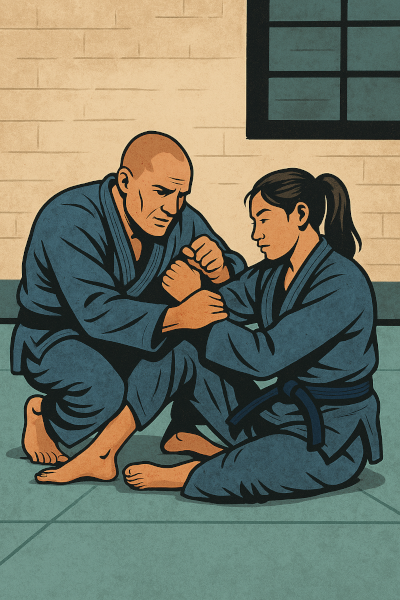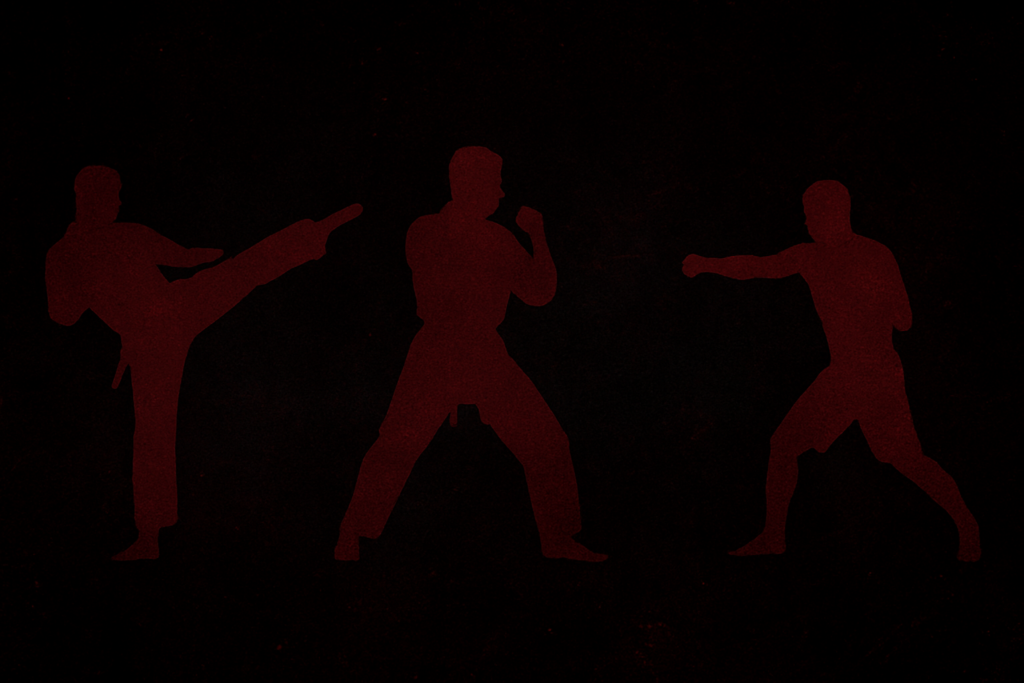The Gentle Art of Ground Control
🧠 A Brief History of Brazilian Jiu-Jitsu

Brazilian Jiu-Jitsu (BJJ), often called “the gentle art,” is a modern martial art that evolved from Japanese Judo and traditional Jujutsu.
Its story begins in the early 1900s when Mitsuyo Maeda (1878–1941), a student of Judo founder Jigoro Kano, traveled the world demonstrating and teaching his art.
In Brazil, Maeda taught the Gracie family, who adapted Judo’s grappling techniques into a more ground-based system focused on leverage, submissions, and real-world effectiveness.
This system became Brazilian Jiu-Jitsu — a martial art emphasizing technique and timing over strength, allowing a smaller person to overcome a larger opponent.
🥋 Main Characteristics of BJJ
- Core Principle: “Technique over strength.”
- Focus: Ground control, positional dominance, and submissions (joint locks and chokes).
- Training Style: Live sparring (rolling) to safely test skills in realistic scenarios.
- Mindset: Calm problem-solving under pressure — a “physical chess match.”
Unlike striking-based arts such as Karate or Taekwondo, BJJ focuses almost entirely on grappling — takedowns, sweeps, and submissions on the ground.
⚔️ The Philosophy of BJJ
At its core, BJJ teaches that intelligence and technique can defeat raw power.
It builds resilience through continuous challenge: every sparring round is a test of control, adaptability, and composure.
A famous quote from Helio Gracie (1913–2009) — one of BJJ’s key pioneers — captures the essence:
“Jiu-Jitsu is the triumph of human intelligence over brute strength.”
BJJ is not just a martial art — it’s a lifelong pursuit of problem-solving, humility, and personal growth.
🏯 The Founders and Evolution of BJJ
| Key Figure | Dates | Contribution |
|---|---|---|
| Mitsuyo Maeda | 1878–1941 | Japanese judoka who introduced Judo to Brazil; teacher of Carlos Gracie. |
| Carlos Gracie Sr. | 1902–1994 | Founder of the Gracie lineage; adapted Maeda’s teachings to create Brazilian Jiu-Jitsu. |
| Helio Gracie | 1913–2009 | Refined BJJ for smaller practitioners; emphasized leverage and defense. |
| Rolls Gracie | 1951–1982 | Modernized BJJ with influence from wrestling and sambo. |
| Rickson & Royce Gracie | 1958– / 1966– | Popularized BJJ globally through competition and the early UFC events. |
From family dojos in Rio de Janeiro to gyms worldwide, BJJ’s growth has been explosive — combining tradition, sport, and practical self-defense.
🧩 Main Styles and Approaches in BJJ
While all BJJ schools share the same foundation, different academies emphasize specific training focuses:
| Style | Key Traits |
|---|---|
| Gracie Jiu-Jitsu | Focused on self-defense and leverage; realistic for smaller practitioners. |
| Sport BJJ | Competition-oriented; emphasizes points, sweeps, and positional control. |
| No-Gi BJJ | Practiced without the kimono (gi); faster pace, with grips on the body. |
| Submission Grappling | Hybrid form combining BJJ, wrestling, and sambo; popular in tournaments like ADCC. |
Many practitioners enjoy training both gi and no-gi to develop versatility and adaptability.
💪 Training and Progression
BJJ is known for its belt system, which reflects both skill and character development:
| Belt | Typical Practitioner Stage |
|---|---|
| White | Beginner — learning basic positions and escapes. |
| Blue | Solid fundamentals, beginning to develop personal style. |
| Purple | Intermediate — strong understanding of techniques and strategy. |
| Brown | Advanced — refining transitions and submissions. |
| Black | Mastery of fundamentals and teaching ability. |
Progress is slow but meaningful — earning a belt in BJJ is a symbol of persistence and humility.
There are no shortcuts; only time, effort, and mat experience.
🧍♂️ Who Can Practice BJJ?
BJJ is for everyone — regardless of age, body type, or athletic background.
| Group | Benefits |
|---|---|
| Children | Builds confidence, discipline, and respect; promotes safe play through controlled grappling. |
| Adults | Improves strength, endurance, and stress management; great for fitness and focus. |
| Seniors | Encourages mobility, flexibility, and low-impact exercise; adaptable pace possible. |
Because technique is more important than strength, even beginners can succeed against stronger partners through leverage and strategy.
🧘 Benefits of Practicing BJJ
Physical Benefits:
- Improves full-body strength and flexibility
- Excellent cardio workout
- Enhances body awareness and coordination
Mental Benefits:
- Builds patience, problem-solving, and focus
- Teaches resilience under pressure
- Fosters humility and persistence
Lifestyle Benefits:
- Strong community and camaraderie in dojos
- Boosts confidence and mental toughness
- Provides practical self-defense for real situations
🥇 BJJ as a Sport
Today, BJJ is one of the fastest-growing martial arts worldwide.
Major tournaments — like the IBJJF World Championships and ADCC Submission Grappling World Championships — attract thousands of competitors.
In sport BJJ, athletes score points for positions such as mount, back control, and guard passes — but ultimate victory comes through submission.
This blend of strategy and technique makes BJJ both a sport and an art form.
🌎 Why You Should Try BJJ
Brazilian Jiu-Jitsu offers more than physical skills — it teaches you to stay calm under stress, to adapt, and to think strategically in every challenge.
Whether you want fitness, competition, or a form of meditation through motion, BJJ meets you where you are.
🥋 BJJ turns struggle into strategy — one roll at a time.

